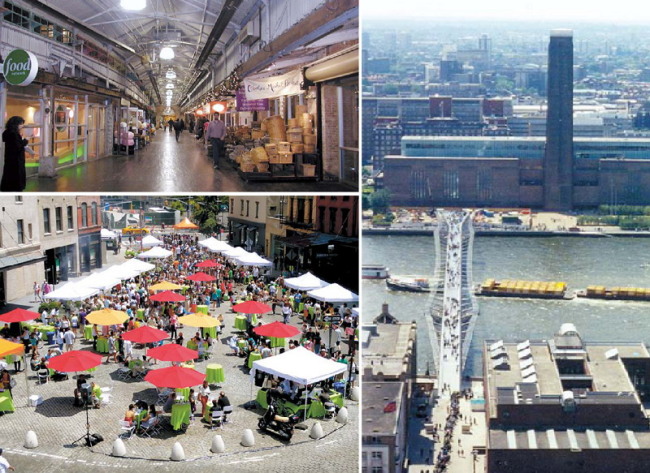This is the second in a weekly series that examines the expanding role of design in the run-up to the Herald Design Forum 2014 on Nov. 26. ― Ed.
A dingy overpass that blocked the sky was torn down to make way for a stream full of life. A waste landfill was transformed into an ecological park with meadows and silvery grass fields. Dilapidated factories were turned into work spaces for artists, museums and galleries.
Urban restoration is the fashionable new paradigm of urban design and can change people’s lives.
Antiquated buildings are no longer dismantled altogether to be replaced by new ones. Urban restoration is about preserving tradition and history while revitalizing the city economically, socially and culturally with new designs in order to improve people’s lives.
In contrast to the rampant redevelopment or remodeling projects which were merely aimed at generating short-term profit, urban restoration is a new people-centered model for sustainable urban design.
While having a longer history in advanced nations, the urban restoration movement gained attention in Korea only a few years back. A special law to encourage and support urban restoration was enacted just last year.
Urban restoration needed as Korea enters recentralizationGenerally, as a city grows, it goes through urbanization, where an increasing number of people migrate from rural to urban areas for economic activities, followed by a stage of decentralization, or urban sprawl, in which people move out to suburban areas, and then a recentralization stage where they return to the city center.
In the process, the population grows older due to the low birthrate. An economy that used to depend on its manufacturing-focused secondary industry becomes heavier on high-tech industries and technology-intensive service industries.
The recentralization stage sees a high demand for redevelopment and an increasing need for urban restoration in order to adapt to the changing industrial landscape.
In Korea, decentralization occurred during the late 1980s, when a demand for new suburban developments hiked. Since 2000, the housing demand in new neighbourhoods declined with downtown residential complexes becoming more popular, hinting at a transition to the recentralization stage.
A city reborn through design
A major goal of urban restoration is to create a sustainable environment that meets high standards.
“People who engage in knowledge-creating information industries flock to places that not only offer pleasant residential surroundings but also meet their educational, cultural, artistic and entertainment needs,” said Koo Ja-hoon, a professor at Hanyang University’s Graduate School of Urban Studies.
“Design strategies are used abroad to offer upscale spaces.”
New York is a typical example of successful design policies.
In addition to its policy of “privately owned public spaces,” or “POPS” ― an amenity provided and maintained by a developer for public use in exchange for additional floor area ― the city actively supported creative, private-led urban restoration projects.

(Counterclockwise from top left) Chelsea Market, New York; the Meatpacking District, New York; and Tate Modern, London, are examples of successful urban renewal projects. (The Herald Business)
Such efforts led to the repurposing of a disused section of railway into an urban park called the High Line Park, and restoration of the Meatpacking District and Chelsea Market.
London rolled out its urban policies in two directions.
One was improving the residential environment in run-down areas, the other was cultural and design policies to revitalize city centers.
“London took up an urban design policy to establish a master plan for the entire city and execute it,” Koo said.
The best-known projects include Tate Modern, a modern art gallery housed in what was previously a power station and run by a charity with free admission; and Brick Lane, a street full of Anglo-Indian cuisine, fine art and fashion, where a former brewery was turned into thriving night clubs.
Key to successful urban restoration
Prolonged periods of decentralization in cities lead to a declining population and deterioration.
“Cities that wisely respond to decentralization continue to grow,” Koo said, pointing to two things essential in urban restoration.
One is securing the competitiveness of the existing city center, subcenters and new commercial subcenters. This means building high-end infrastructure to attract professionals and creative manpower.
The other is creating a delightful place to live by sprucing up old neighborhoods and invigorating local communities.
Whereas redevelopment and remodeling are limited to improving the physical environment, urban restoration goes further to embrace socioeconomic changes as well, according to Koo.
“For an urban restoration project to succeed, it should come with related programs that encourage various types of participation by residents,” he said.
“Urban maintenance also requires a comprehensive social, economic and cultural approach as well as efforts to help the original residents settle.”
By Moon Young-gyu, The Herald Business
(ygmoon@heraldcorp.com)
Kim So-hyun translated this article. ― Ed.





![[From the Scene] Monks, Buddhists hail return of remains of Buddhas](http://res.heraldm.com/phpwas/restmb_idxmake.php?idx=645&simg=/content/image/2024/04/19/20240419050617_0.jpg&u=20240419175937)
